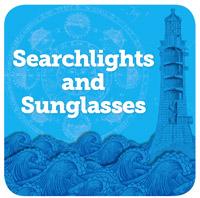
‘Pencils down everyone. Your digital toolbox is here’: Five lessons from ‘Searchlights and Sunglasses’
Knight Foundation asked the students, educators and professionals who beta tested our new digital teaching tool, “Searchlights and Sunglasses,” for their five favorite lessons. The book explores the digital transformation of journalism, and with one click turns into a classroom tool, offering a learning layer with 1,000 lesson plans and resources for educators. We will be posting our beta testers responses over the coming weeks here on KnightBlog.

By Ruben O. Valadez, journalism teacher at Eagle Pass High School in Eagle Pass, Texas
As a high school journalism teacher, here are five things I’ve taking away from reading “Searchlights and Sunglasses”:
Lesson #1: The future is here, and it looks amazing.
Eric Newton uses the first section of his book to offer a survey of the development of media. But more importantly, he takes a looks ahead: all the way to the year 2076. What Newton finds there is fantastical, exciting, and perhaps eerily prescient.
Newton foresees the rise of “intelligent media,” a landscape populated with news bots, news drones, and robot scribes. This, I believe, is sure to spark the imagination of the future journalists under our care. Related Links

Continue the conversation with #edshift and at edshift.org.
Free Poynter webinar Oct. 28: “Six things educators can do right now to go digital.”
“Getting students to ask tough questions: My 5 favorite parts of “Searchlights and Sunglasses” on KnightBlog
“Navigating Knight’s new book: Choose Your Own Adventure” on KnightBlog
His theory is that thinking outside the box and taking a cue from science fiction is the best way to ensure that the next generational shift in media is as productive as the shifts that have come before it. His call to action is to “push the frontier of news.” I expect students to be fully engaged with learning layer activities such as researching alternative techniques to telling news stories and coming up with one of their own. The future is now, and the sooner our students begin thinking about the future of news, the sooner they will set about changing it.
Lesson #2: The more things change, well, you better change with them.
Newton’s message to future journalists is clear: there will be jobs out there, but you might have to create them yourselves – and you better be comfortable with change. Teachers are in a unique position to understand how today’s students are engaging the changing world around them. Spend any considerable amount of time around teenagers, and you will understand that they are malleable, forward-thinking risk takers. Millenials especially, are coming of age in a digital world changing almost at light speed.
Newton gets it. Perhaps more than any generation that came before, our students are perfectly poised to become the next communicators. His message to student journalists that “Yes, there are jobs” will serve to motivate and inspire.
Lesson #3: Pencils down everyone, your digital toolbox is here.
“Searchlights and Sunglasses” does more than just offer an abstract vision of the digital future of journalism. Newton puts his money where his mouth is. In the section titled “Ten tools to learn, more to explore,” he actually presents students with the tools journalists are wielding in the new frontier. Teachers using this book will do themselves and their students a great service by learning about innovations such as DocumentCloud and Zeega. Use the learning layer to have your students explore WordPress and become bloggers. This will be of special value to schools serving historically underrepresented populations, where students might not be used to having a voice and a presence in a larger media landscape.
Lesson #4: My smart phone is compatible with the First Amendment.
Students will be thrilled to find in the section titled “As social media grows, so does First Amendment appreciation” that social media does the Constitution good. Newton’s point is that the people who are now using these platforms more and more to communicate are the very people who are the most interested in the protection of free expression. This section will fit in perfectly in a unit on the First Amendment to make the lesson relevant and timely. The learning layer is chock-full of resources and activities from the history of the crafting of the First Amendment to the meaning of freedom in the age of security cameras.
Lesson #5: The food pyramid can teach us something about the inverted pyramid.
In the section titled “How much comfort news is in your information diet,” Newton cautions against consuming opinion disguised as fact because it makes us feel good. News literacy should be a part of every journalism curriculum. Our student journalists cannot be effective members of the media ecosystem unless they become discerning and aware media consumers first. Students are sure to enjoy the parallels Newton draws between nutritional labels with “newstritional” information. Also engaging will be activities like asking students to keep a media diary, root out bias in the media, and analyze attacks in politics.
Ruben O. Valadez is a journalism teacher at Eagle Pass High School in Eagle Pass, Texas.
Recent Content
-
Journalismarticle ·
-
Journalismarticle ·
-
Journalismarticle ·


